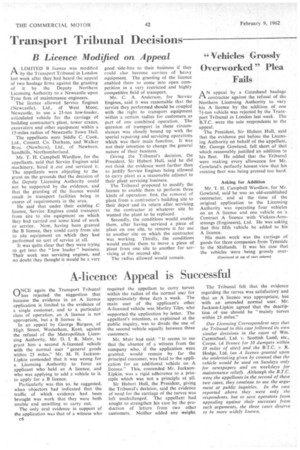A-licence Appeal is Successful
Page 38

If you've noticed an error in this article please click here to report it so we can fix it.
QNCE again the Transport Tribunal has rejected the suggestion that because the evidence in an A licence application is limited to the evidence of a single customer, and to a particular class. of operation, an A licence is not appropriate, but a B licence is.
In an appeal by George Burgess, of High Street, Westerham, Kent, against the refusal of the Metropolitan Licensing Authority, Mr. D. I. R. Muir, to grant him a second A-licensed vehicle with the normal user "general goods within 25 miles," Mr. M. H. JacksonLipkin contended that it was wrong for a Licensing Authority to force an applicant who held an A licence, and who was applying to add a vehicle to it. to apply for a B licence.
Particularly was this so, he suggested, when objectors had indicated that the traffic of which evidence had been brought was work that they were both unable and unwilling to carry out.
The only oral evidence in support of the application was that of a witness who c6 required the appellant to carry turves within the radius of the normal user for approximately three days a week. The main user of the applicant's other A-licensed vehicle was Marley Tiles, who supported the application by letter. The appellant's intention, as explained at the public inquiry, was to divide the use of the second vehicle equally between three customers.
Mr. Muir had said: "It seems to me that the absence of a witness from the company who, if the application were granted, would remain by far the principal customer, was fatal to the application for an additional vehicle on A licence." This, contended Mr. JacksonLipkin, was a rigid adherence to a principle which was not a principle at all.
Sir Hubert Hull, the President, giving the Tribunal's decision, said the evidence of need for the carriage of the turves was left unchallenged. The appellant had sought to strengthen his case by the production of letters from two other customers. Neither added any weight. The Tribunal felt that the evidence regarding the turves was satisfactory and that an A licence was appropriate, but with an amended normal user. Mr. Jackson-Lipkin agreed that the description of use should be "mainly turves within 25 mites."
Our Licensing Correspondent says that the Tribunal in this case followed its own similar decisions in the cases of Wm. Carmichael, Ltd. v. Scottish Land, etc., Corpn. (A licence for 10 dumpers within 10 miles of sites) and the B.T.C. v. E.. Hodge, Ltd. (an A licence granted upon the undertaking given by counsel that the vehicle would be used on Sundays only for newspapers and on weekdays for maintenance relief). Although the B.T.C. were the appellants in the second of these two cases, they continue to use the argument at public inquiries. In the case reported above they were only the respondents, but to save operators from appealing against their successes from such arguments, the three cases deserve to he more widely known.
















































































































